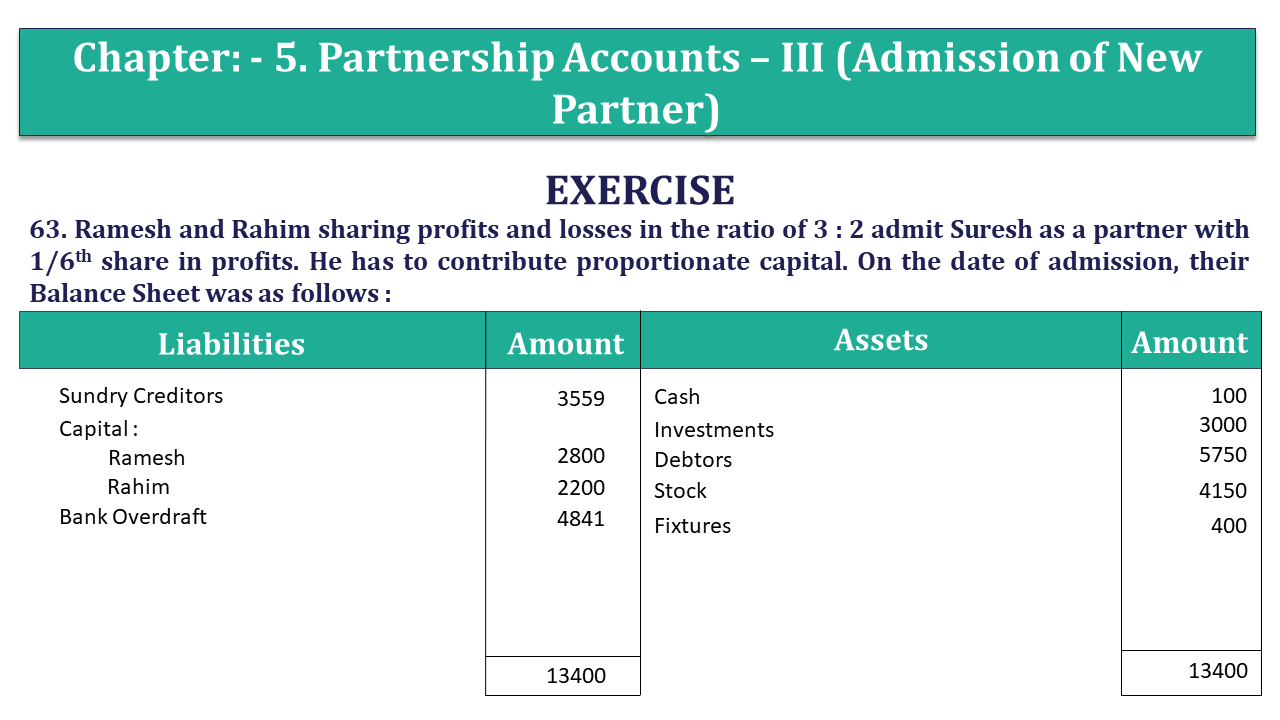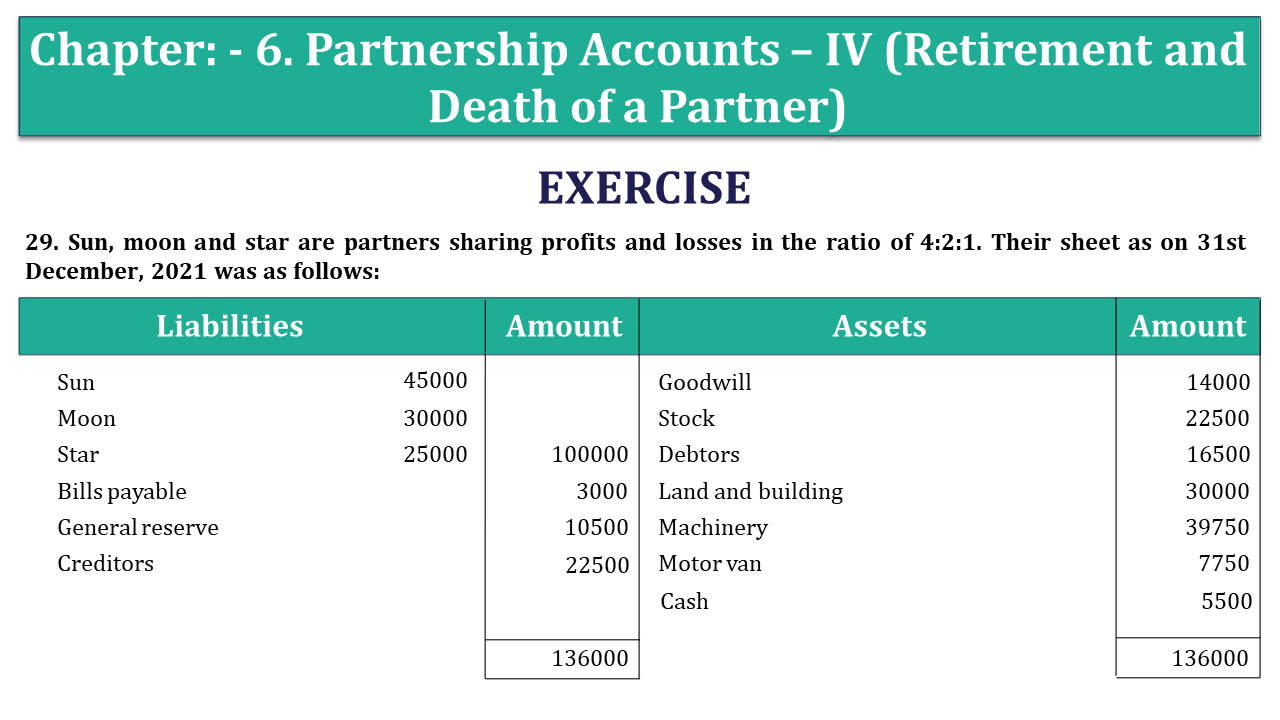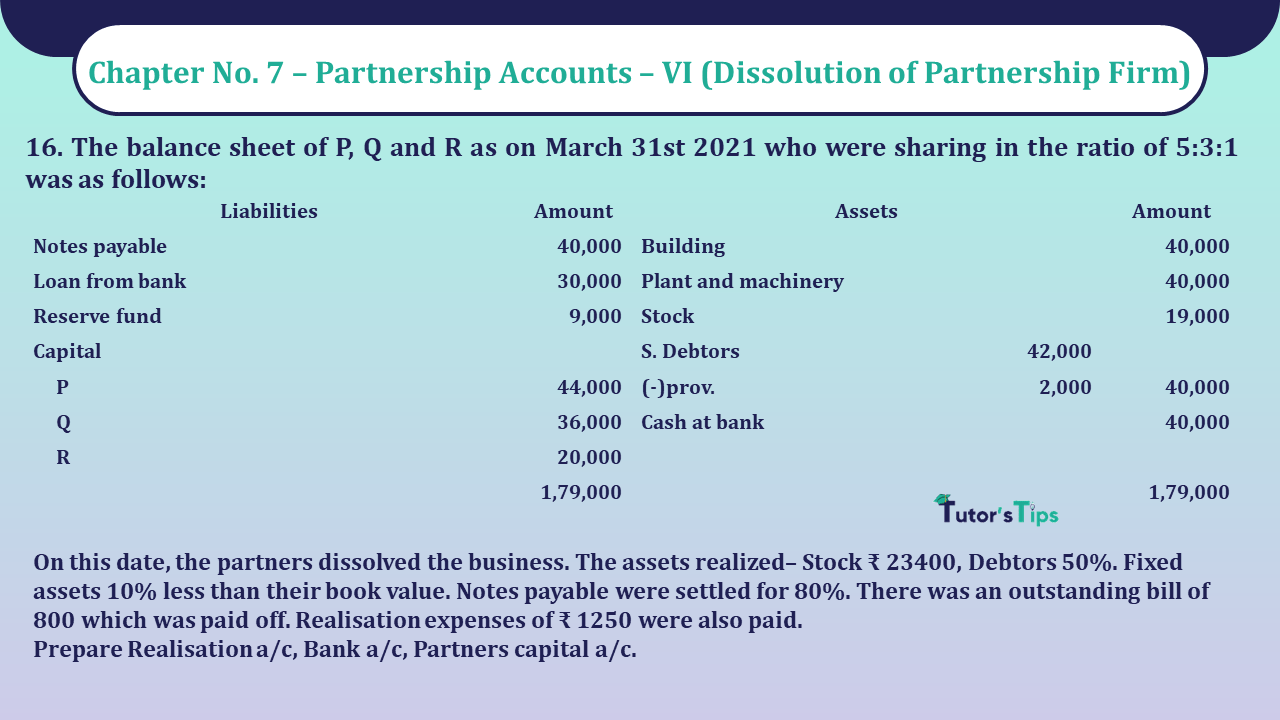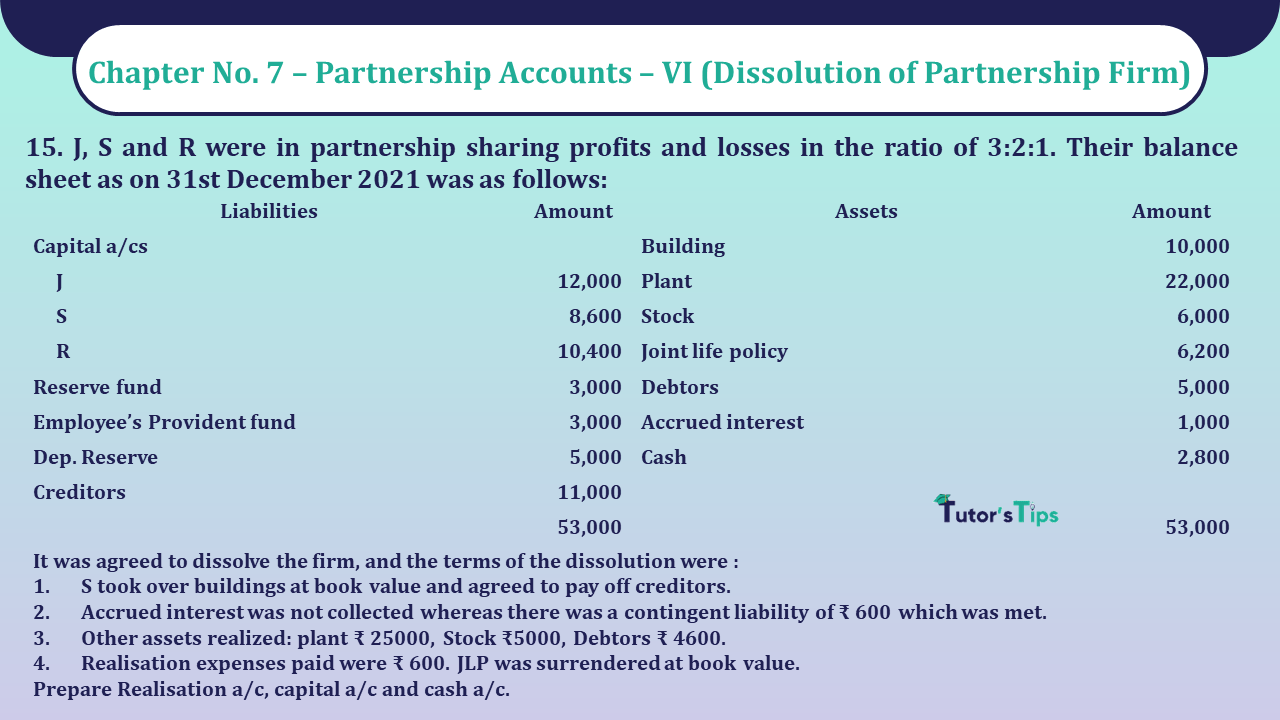Question 63 Chapter 5 – Unimax Class 12 Part 1 – 2021
63. Ramesh and Rahim sharing profits and losses in the ratio of 3 : 2 admit Suresh as a partner with 1/6th share in profits. He has to contribute proportionate capital. On the date of admission, their Balance Sheet was as follows :
| Liabilities | Amount | Assets | Amount |
| Sundry Creditors | 3559 | Cash | 100 |
| Capital : | Investments | 3000 | |
| Ramesh | 2800 | Debtors | 5750 |
| Rahim | 2200 | Stock | 4150 |
| Bank Overdraft | 4841 | Fixtures | 400 |
| 13400 | 13400 |
It is agreed to make the following adjustments in the above Balance Sheet.
- To transfer Rs. 2000 from Suresh’s Current A/c (newly opened) to old partners’ capital A/cs for share of goodwill (Suresh is unable to bring goodwill in cash).
- To create a reserve at 10% on the debtors for doubtful debts.
- To write down Fixtures to Rs. 100.
- To depreciate Stock by 10%.
- To increase the value of investments to Rs. 3500.
The capitals of the partners were to be adjusted in profit sharing ratio. Make entries necessary to give effect to the above arrangement and prepare the amended Balance Sheet immediately after Suresh has become a partner.
The solution of Question 63 Chapter 5 – Unimax Class 12 Part 1: –
Journal
| Date | Particulars | L.F. | Debit | Credit | |
| Investments a/c | Dr. | 500 | |||
| To Revaluation A/c | 500 | ||||
| (Being value of assets increased) | |||||
| Revaluation a/c | Dr. | 1290 | |||
| To Provision for doubtful debts a/c | 575 | ||||
| To Furniture a/c | 300 | ||||
| To Stock a/c | 415 | ||||
| (Being value of asset decreased & liabilities increased) | |||||
| Ramesh’s Capital a/c | Dr. | 474 | |||
| Rahim’s Capital A/c | Dr. | 316 | |||
| To Revaluation a/c | 790 | ||||
| (Being loss on revaluation transferred to old partner’s capital a/c in old ratio) | |||||
| Suresh’s Current a/c | 2000 | ||||
| To Ramesh’s Capital A/c | 1200 | ||||
| To Rahim’s Capital a/c | 800 | ||||
| (Being amount of goodwill transferred to old partners’ capital a/c from Suresh’s current a/c | |||||
| Cash a/c | Dr. | 1242 | |||
| To Suresh’s Capital A/c | 1242 | ||||
| (Being capital introduced by new partner) | |||||
| Cash a/c | Dr. | 200 | |||
| To Ramesh’s Capital A/c | 200 | ||||
| (Being capital introduced by old partner) | |||||
| Rahim’s Capital a/c | Dr. | 200 | |||
| To Cash A/c | 200 | ||||
| (Being capital withdrawn by old partner from the business) |
Revaluation A/c
| Particulars | Rs. | Particulars | Rs. | |
| To Provision for bad debts a/c | 575 | By Investments a/c | 500 | |
| To Furniture a/c | 300 | By Loss on revaluation | ||
| To Stock a/c | 415 | Ramesh ( 3 : 2 ) | 474 | |
| Rahim | 316 | 790 | ||
| 1290 | 1290 |
Capital Accounts
| Particulars | Ramesh | Rahim | Suresh | Particulars | Ramesh | Rahim | Suresh |
| To Loss on revaluation | 474 | 316 | – | By Balance b/d | 2,800 | 2,200 | – |
| To Cash a/c | – | 200 | – | By Suresh current a/c | 1,200 | 800 | – |
| To Balance c/d | 3,726 | 2,484 | 1,242 | By Cash a/c | 200 | – | – |
| By Cash a/c | – | – | 1,242 | ||||
| 4,200 | 3,000 | 1,242 | 4,200 | 3,000 | 1,242 |
Balance Sheet
| Liabilities | Rs. | Assets | Rs. | ||
| Bank overdraft | 4841 | Suresh current a/c | 2,000 | ||
| Capital Accounts | Debtors | 5,750 | |||
| Ramesh | 3726 | Less : Provision | 575 | 5,175 | |
| Rahim | 2484 | Cash (100 + 1242 + 200 -200) | 1,342 | ||
| Suresh | 1242 | 7452 | Investments | 3,500 | |
| Suresh | 3559 | Stock | 3,735 | ||
| Fixtures | 100 | ||||
| 15,852 | 15,852 |
Working Note:
Sacrificing Ratio = 3 : 2 if nothing has been mentioned in partnership deed except new partner’s share (it is assumed)
Advertisement-X
(A) Calculation of Capital contributions by partners :
Total Capital of firm = (Ramesh capital balance c/d + Rahim’s capital balance c/d) X 6/5
= (3526 + 2684) X 6/5
= Rs. 7452
(i) Ramesh’s required capital = 3/6 X 7452 = Rs. 3726
Ramesh’s actual capital = Rs. 3526
Ramesh’s will introduce Rs. 200 in business
(ii) Rahim’s required capital = Rs. 2/6 X 7452 = Rs. 2484
Rahim’s actual capital = Rs. 2684
Rahim’s will withdraw Rs. 200 from business
(iii) Suresh’s capital = 1/6 X 7452 = Rs. 1242
(B) New PSR :
Advertisement-X
Let total share = 1
Suresh share = 1/6 Remaining share = 1 – 1/6 = 5/6
Ramesh’s new share = 3/5 X 5/6 = 3/6
Rahim’s new share = 2/5 X 5/6 = 2/6
Suresh’s share = 1/6
New PSR = 3 : 2 : 1 Ans.
What is Partnership – Meaning and Its 4 Types
T.S. Grewal’s Double Entry Book Keeping +2 (Vol. I: Accounting for Not-for-Profit Organizations and Partnership Firms)
- Chapter No. 1 – Financial Statement of Not-For-Profit Organisations
- Chapter No. 2 – Accounting for Partnership Firms – Fundamentals
- Chapter No. 3 – Goodwill: Nature and Valuation
- Chapter No. 4 – Change in Profit-Sharing Ratio Among the Existing Partners
- Chapter No. 5 – Admission of a Partner
- Chapter No. 6 – Retirement/Death of a Partner
- Chapter No. 7 – Dissolution of a Partnership Firm
T.S. Grewal’s Double Entry Book Keeping (Vol. II: Accounting for Companies)
- Chapter No. 8 – Company Accounts – Accounting for Share Capital
- Chapter No. 9 – Company Accounts – Issue of Debentures
- Chapter No. 10 – Redemption of Debentures
T.S. Grewal’s Double Entry Book Keeping (Vol. II: Accounting for Companies)
- Chapter No. 1 – Financial Statements of a Company
- Chapter No. 2 – Financial Statement Analysis
- Chapter No. 3 – Tools of Financial Statement Analysis – Comparative Statements and Common- Size Statements
- Chapter No. 4 – Accounting Ratios
- Chapter No. 5 – Cash Flow Statement
Check out T.S. Grewal +2 Book 2020@ Official Website of Sultan Chand Publication







Leave a Reply